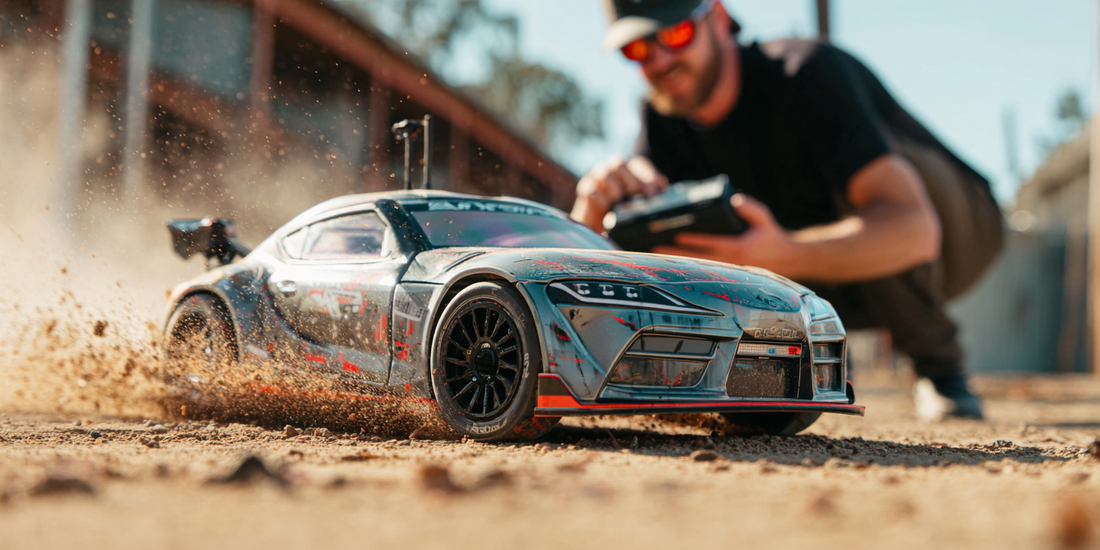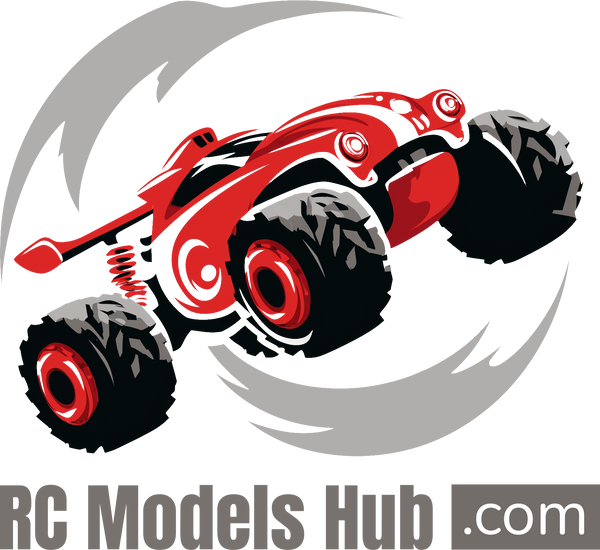
Master RC Drifting: Setup & Techniques for Smooth Slides
Share
RC drifting brings the thrill of controlled slides and high-speed cornering to the world of remote-controlled cars, blending precision driving with technical setup. Whether you're a beginner looking to start with a drift RC car or an enthusiast refining your skills, mastering RC drifting requires understanding your vehicle’s setup and practicing key techniques. This guide covers essential steps to prepare your RC drift car and develop smooth, consistent slides, making it accessible for newcomers while offering insights for more experienced drivers.
Choosing the Right RC Drift Car
Selecting a suitable RC drift car sets the foundation for successful drifting. Most drift cars are 1/10 or 1/28 scale, with popular models like the Kyosho MA-020 Mini-Z or WLtoys 284131 offering beginner-friendly features. Look for a car with a low center of gravity, all-wheel drive (AWD) or rear-wheel drive (RWD) suited for drifting, and adjustable suspension. AWD systems, like those in the Kyosho MA-020, provide balanced traction for easier slides, while RWD models, such as the Kyosho MR-04, demand more skill but offer authentic drift dynamics. Kits may require assembly, which allows customization but can be complex for beginners, whereas Ready-to-Run models come pre-assembled for immediate use. However, pre-built models may have fixed settings, limiting initial tweakability.
Consider the motor type: brushed motors are affordable and sufficient for beginners, while brushless motors, found in models like the ARRMA Mojave GROM, deliver higher speeds but require more control. Ensure the car includes drift tires—hard plastic or slick compounds designed for sliding—rather than standard rubber tires, which grip too much. Budget-friendly options may lack durability, with plastic components prone to wear during crashes, so investing in a model with metal gears or upgrade potential can save time.
Setting Up Your RC Drift Car
A well-tuned RC drift car is critical for smooth slides. Here’s how to configure your vehicle for optimal drifting performance:
Tires and Wheels
Drift tires are the cornerstone of RC drifting. Hard plastic tires, like those on the WLtoys 284131, reduce grip to enable sliding, while slick tires offer a balance of control and drift. Check that tires are evenly worn, as uneven wear can cause inconsistent slides. Some hobbyists sand tires lightly to adjust grip levels, but this may accelerate wear on abrasive surfaces like concrete. Ensure wheels are securely mounted, as loose wheels can disrupt balance during high-speed drifts.
Suspension and Camber
Adjust the suspension to be stiffer in the rear to promote oversteer, a key element of drifting. Softer front springs help initiate slides, while adjustable shocks, like those on the Kyosho MA-020, allow fine-tuning. Set a slight negative camber (wheels tilted inward at the top) to improve tire contact during cornering. Too much camber, however, can reduce stability, so start with a 1–2-degree angle and test incrementally. Some budget cars have non-adjustable suspensions, limiting setup flexibility.
Weight Distribution and Chassis
A balanced weight distribution enhances drift control. Position the battery low and centered to lower the center of gravity, as seen in Mini-Z chassis designs. Some cars, like the WLtoys 284131, have metal chassis for durability, but plastic chassis may flex under stress, affecting handling. Adding small weights to the rear can help initiate drifts but may slow acceleration if overdone. Check for chassis tweaks like toe-in (front wheels slightly inward) to stabilize high-speed slides.
Gyro and Electronics
Many drift cars, such as the FLYCOLOR Turbo Racing C64, include a gyro to stabilize steering during slides. Adjust the gyro sensitivity to counter oversteer without making the car feel rigid. A 2.4GHz transmitter with proportional control, common in most modern RC drift cars, ensures precise throttle and steering inputs. However, low-quality ESCs in budget models may overheat during long sessions, so monitor runtime and allow cooldown periods.
Mastering Drifting Techniques
Once your car is set up, practice these techniques to achieve smooth, controlled slides:
Initiating the Drift
Start on a smooth surface like a polished floor or RC drift track. Approach a corner at moderate speed, then quickly turn the steering wheel while applying a short burst of throttle. This breaks traction, causing the rear to slide. For AWD cars, maintain steady throttle to sustain the slide; for RWD, feather the throttle to control the angle. Beginners may find initiating drifts challenging due to oversteering, so practice on wide corners to build confidence.
Maintaining the Slide
To hold a drift, balance throttle and steering inputs. Counter-steer by turning the wheels opposite to the slide direction, keeping the car’s nose pointed toward the corner’s apex. Use small throttle adjustments to control speed—too much throttle can spin the car, while too little may cause it to straighten out. Practice on figure-eight patterns to develop muscle memory. Some cars, like budget models, may struggle with consistent slides due to less precise ESCs, requiring more manual correction.
Exiting the Drift
Smoothly exit a drift by gradually reducing throttle and straightening the wheels as you exit the corner. Avoid abrupt inputs, which can cause spins or loss of control. Practice transitioning between corners to maintain flow, especially on tracks with multiple turns. RWD cars require precise throttle control to avoid fishtailing, while AWD models are more forgiving but may feel less dynamic.
Track and Surface Considerations
Drift on smooth, low-grip surfaces like polished concrete, vinyl, or dedicated RC drift tracks. Rough surfaces like asphalt increase tire wear and reduce slide consistency. Create a simple track with cones or tape to practice cornering lines. Avoid wet surfaces, as water can damage electronics in non-waterproof models, a common issue with budget drift cars.
Advanced Tips for Intermediate Drifters
For those comfortable with basic drifting, consider these technical adjustments to refine performance:
- Gear Ratios: Adjust the pinion gear (e.g., 29T–37T in Kyosho models) to balance torque and speed. A smaller pinion increases torque for tighter slides but reduces top speed. Experiment with gear ratios to match your track’s layout, noting that frequent changes may wear gears in budget models.
- Differential Tuning: Lock the rear differential for more predictable slides, especially in AWD cars like the WLtoys 284131. Use thicker diff grease to reduce slip, but avoid over-tightening, which can strain the motor. Some feedback notes tight diffs in WLtoys models, causing motor heat, requiring periodic checks.
- ESC Programming: Program the ESC for smoother throttle response using the manufacturer's software or a programming card. Adjust punch and drag brake settings to fine-tune drift initiation, though budget ESCs may lack advanced programmability.
- Upgrade Parts: Install metal suspension arms or brass weights to improve durability and stability. For example, upgrading the WLtoys 284131 with metal parts reduces flex but increases weight, slightly affecting speed. Check compatibility with aftermarket parts like Kyosho’s MZW431 gyro unit for enhanced control.
- Tire Compounds: Experiment with hybrid tires (e.g., ABS or PVC blends) for varied grip levels. Softer compounds wear faster but improve slide control on slick tracks. Test on different surfaces to find the optimal compound.
Conclusion
Mastering RC drifting combines a technical setup with practiced driving skills. Start with a beginner-friendly RC drift car, fine-tune the tires, suspension, and gyro, and practice initiating and maintaining slides on a smooth track. While challenges like oversteering or component wear may arise, especially with budget models, the thrill of chaining smooth drifts makes the effort worthwhile. For intermediate drifters, tweaking gear ratios, differentials, and upgrades can elevate performance, turning casual slides into precision drifts. With patience and practice, you’ll navigate corners with confidence, bringing the excitement of RC drifting to life.
